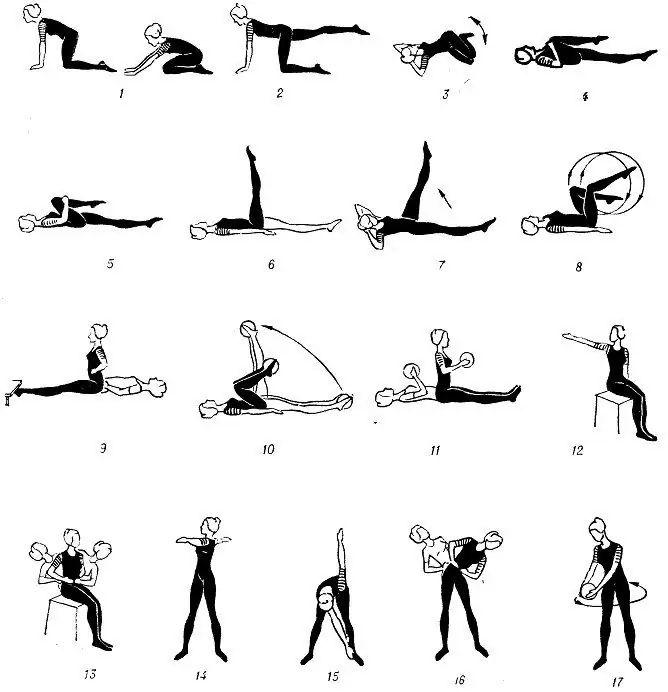- Author Rachel Wainwright [email protected].
- Public 2023-12-15 07:39.
- Last modified 2025-11-02 20:14.
Bowel exercises for constipation
The content of the article:
-
Complex of gymnastics for the intestines with constipation
- Exercise for spastic constipation
- Physiotherapy exercises against atonic constipation
- Contraindications
- General information about the disease
- Video
Exercises for the intestines with constipation show especially good results if the pathology is caused by a sedentary lifestyle, impaired intestinal motor function.
Exercises with delayed bowel movements help to improve intestinal motility, and also allow you to strengthen the muscles of the diaphragm, press, pelvic floor, and stimulate the passage of gases if the patient has flatulence.
To effectively treat delayed bowel movements, exercise should be done regularly. After eating, at least 2 hours must pass before charging begins. It is best to exercise in the morning on an empty stomach.

Therapeutic exercises should be selected by the attending physician. Complexes developed by specialists are often used (for example, gymnastics by Dr. Bubnovsky). The exercise therapy instructor should show how to do exercises for an adult and a child, the first few times it is advisable to do it under his control, later you can do it at home on your own.
Complex of gymnastics for the intestines with constipation
The following exercises are used to troubleshoot the problem:
- The patient takes the initial position lying on his back, then bends his knees and performs movements that imitate riding a bicycle. The exercise is repeated 30 times in 1 approach.
- From the same starting position, the patient bends the knees and pulls them with his hands to the stomach, after which he returns to the starting position. These steps are repeated 10 times.
- Being in the same starting position, the person simultaneously raises both lower limbs and tries to throw them behind the head, after which he returns to the starting position. The actions are repeated 10-15 times.
- The patient takes a starting position standing, hands are lowered along the torso, takes a deep breath and sucks in the abdomen, after which he relaxes the abdominal muscles. These actions are repeated 5-8 times.
Finish the exercise by walking on the spot, raising your knees high, for 2-3 minutes.
Exercise for spastic constipation
The following exercises can help you quickly get rid of spastic constipation:
- The patient takes the starting position standing with feet shoulder-width apart, wraps his palms around the lower back and alternately tilts the body to the right and left (4 times in each direction).
- From the same starting position, the person makes circular movements with the body to the right and left. At the same time, the pelvis remains motionless. Repeat 4 times in each direction.
- The patient takes the initial position lying on his stomach with straightened legs (feet together), putting his bent arms in front of him, and makes light swaying of the pelvis from side to side. The back muscles are relaxed.
- From the same starting position, the person raises the right leg, throws it over the left, lightly touching the floor, and returns to the starting position. After that, the same actions are performed for the left leg. The exercise is repeated 4 times for each limb.
- While in the same starting position, the patient bends the right leg at the knee and pulls it towards the right arm, and then returns to the starting position. Actions are performed 4 times for each leg.
- From the same starting position, the person stretches the body while simultaneously raising the left arm and right leg, and then returns to the starting position. Repeat 4 times for each pair of limbs.
- The starting position is lying on your back, legs are straightened, arms are along the body. After that, you need to lift one leg up, holding it for a while in this position, and return to the starting position. Perform 4 times for each lower limb.
- From the same starting position, the patient puts his hands locked in the lock under his head, while exhaling, he tries to connect the elbow of the left hand with the knee of the right leg (due to the abdominal muscles), returns to the starting position, after which he performs the same actions for the right arm and left leg … Repeat 4 times for each pair of limbs.
- The starting position is standing on all fours, while exhaling, the person simultaneously straightens and stretches the right arm and left leg, returns to the starting position. After that, he performs the same actions for the other pair of limbs. Repeat 4 times.
- Being in the same starting position, the person exhales rounds his back and lowers his head, after which he returns to the starting position. The exercise is repeated 4 times.
Physiotherapy exercises against atonic constipation
With atonic constipation, a gymnastic complex helps:
- The person lies on his back, legs are straight, arms are spread out to the sides. As you exhale, the knee of one leg needs to be wrapped around with your hands and pulled to the chest. At the same time, you need to gently stretch your chin to the chest. The patient returns to the starting position and changes the leg. Repeat 10 times for each of the lower limbs.
- The man sits on the floor, trying to spread his straightened legs as wide as possible, hands on the waist. After that, with the fingers of the left hand, you need to try to get the toe of the right leg, the same actions are performed for the right hand and left leg. Repeat 10 times.
- The patient takes the starting position on all fours. On exhalation, one of the legs needs to be bent at the knee, brought to the chest, pulled back, and returned to its original position. Repeat 10 times for each leg.
- Being in the initial standing position, the person wraps his arms around his waist and turns the body to the right and left 10 times for each side.
- From the same starting position, a person needs to do 10 squats.
Contraindications
Physical therapy aimed at facilitating bowel movements is contraindicated in the following conditions:
- peptic ulcer of the stomach and duodenum;
- umbilical hernia;
- high blood pressure;
- acute abdominal pain;
- fever;
- period of pregnancy in women.
General information about the disease
According to statistics, constipation is diagnosed in 30-50% of adults (older people are more susceptible to them) and up to 20% of pediatric patients.
The occurrence of problems with bowel movement can be associated with the following conditions:
- genetic predisposition;
- organic and functional disorders in the gastrointestinal tract;
- the presence of neoplasms in the body;
- the use of certain medicines;
- frequent stressful situations;
- endocrine disorders;
- improper nutrition;
- inactive lifestyle.
Depending on the causes of development and the available signs, according to one of the classifications, pathology is divided into 2 types, which are presented in the table.
| Pathology type | Explanation |
| Spastic | It develops due to spasms of the intestinal muscles, which prevents the movement of feces through the intestine, is observed against the background of endocrine, hormonal disorders, mental disorders |
| Atonic | It is caused by the weakness of the intestinal muscles, which leads to a slowdown in the movement of feces, discomfort during defecation, often observed in elderly patients, with insufficient physical activity, prolonged work at the computer and being behind the wheel of a car |
Drug therapy for delayed bowel movements may consist in the use of laxatives, antispasmodics, and drugs of other groups, depending on the identified cause. The selection of medicines is carried out taking into account the cause of the development of the pathology, the existing symptoms, contraindications and some other factors.
The complex of treatment also includes other methods:
- diet therapy;
- physiotherapy treatments;
- massage (including self-massage at home);
- breathing exercises.
Any therapeutic measures should be carried out only after consultation with your doctor.
Video
We offer for viewing a video on the topic of the article.

Anna Aksenova Medical journalist About the author
Education: 2004-2007 "First Kiev Medical College" specialty "Laboratory Diagnostics".
Found a mistake in the text? Select it and press Ctrl + Enter.






